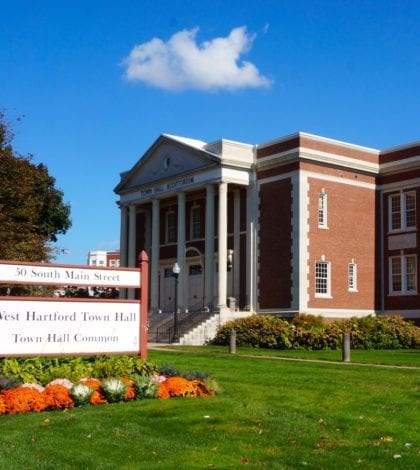Governor Announces Plan to Eliminate All Education Aid for West Hartford

Audio By Carbonatix

West Hartford Town Hall. Photo credit: Ronni Newton
The Executive Order Resource Allocation Plan announced Friday will zero out Education Cost Sharing grant for more than 80 municipalities, is a “nightmare,” official says.
By Abigail Albair, West Hartford Press Editor
Editor’s Note: This article appears courtesy of The West Hartford Press. For this and more news, see next week’s edition. To request a free, weekly copy, visit turleyct.com.
Less than 48 hours after West Hartford sent a letter to the state pleading for the preservation of the town’s Education Cost Sharing grant, Gov. Dannel Malloy released a plan to shift all education aid to Alliance Districts – the poorest in the state – and to consequently zero out all funding for West Hartford and 84 other municipalities.
Fifty-four non-alliance towns “with a greater reliance on state funding,” according to a release from the governor’s office, will have ECS aid reduced as funding is maintained for the 30 districts with “the highest student needs and the greatest reliance on state funding.”
The state continues to operate without a budget as legislators grapple with numbers and have thus far been unable to come to an agreement as to how to handle a growing deficit.
“In the absence of an adopted budget from the General Assembly, my administration is reallocating resources to pay for basic human services, education in our most challenged school districts, and the base operation of government,” Malloy said in a statement. “The municipal aid that is funded as part of this executive order reflects the nearly impossible decisions Connecticut must make in the absence of a budget. It will force some of our municipalities – both large and small – to make similarly difficult choices of their own.”
Malloy is running the state through executive order, which allows him to reallocate funds, but not to raise new revenue. This latest revision to the Executive Order Resource Allocation Plan also restores $40 million to private, nonprofit health and human service providers – as previous reductions forced the providers to make “unacceptable cuts in services” – and makes $60 million in other adjustments “to ensure adequate resources to meet state obligations.”
The plan would take effect in October if the legislature has not adopted a budget by then. The first 25 percent of the ECS payments to the towns slated to receive them would be made in early October.
West Hartford received nearly $21 million in ECS funding in fiscal year 2017 and, although Malloy’s June executive order would have dramatically cut that funding, officials were shocked at the fact that the town would now receive nothing at all.
“The governor’s revised executive order is devastating for our community,” Mayor Shari Cantor said. “I am furious and extremely disappointed. This complete elimination of state aid for our 10,000 diverse student population is shocking.”
In a joint letter to Office of Policy and Management Secretary Benjamin Barnes, dated Aug. 16 – a response to a request he sent to all municipalities earlier this month asking for fiscal information – Cantor and Town Manager Matt Hart said, “it is critical that the state’s action be guided by the reality rather than the perception of West Hartford.”
In an interview with The West Hartford Press, Cantor said she took issue with Malloy’s letter instructing Barnes to gather information from towns, in which he noted municipal aid as the “single largest state expenditure – more than $5 billion of our state budget,” the majority of which is educational aid, and said that, in an effort to hold municipalities harmless, the state has had to drastically alter funding to other areas of government by cutting services, raising revenues, and asking state employees for concessions while town governments have been shielded from making difficult choices.
Cantor said that, while some towns may have been protected by maintaining aid and thereby avoided having to make hard choices, such has not been the case in West Hartford. She said the shift in funding to urban centers at the expense of West Hartford ignores the demographics of the town and its status as an economic stronghold in Greater Hartford.
West Hartford, she said, is a municipality that needs continued investment as it remains one that attracts the development and population Connecticut is seeking.
“The people of West Hartford cannot … face a massive reduction in state revenue or cost shift that would significantly spike property taxes and jeopardize the town’s role as Hartford’s largest neighbor and an economic anchor for the region,” Hart and Cantor wrote in their response to Barnes. “West Hartford has consistently made tough choices to consolidate administrative functions, implement cost controls, collaborate with other cities and towns, carefully invest its funds, anticipate unfunded liabilities, tax as necessary, promote innovative development, and enhance our responsiveness to an increasingly diverse community. Because we have made these tough choices, West Hartford’s economic growth and fiscal stability are major factors in the strength and future of the metropolitan region.”
They note the demographics of the West Hartford public school system, which has a 41.9 percent minority population this year, including 21.4 percent of students whose home language is not English and 21.3 percent of students eligible for free and reduced lunch. Those numbers reflect an increase from a decade ago, when they were 33.4 percent, 17.6 percent and 15 percent, respectively. In that same time, AP participation saw a 74 percent increase.
Those positive results were achieved, Cantor and Hart explained, at a per pupil cost that is more than $1,000 less than the statewide average.
“In total the school budget was $12.4 million less than it would have been if we spent at the statewide average,” they wrote. “Of the 169 towns in Connecticut, West Hartford ranked 128th in per pupil education spending.”
Cantor said the town does its best to meet the needs of all students.
“This has become more challenging as students needs have grown,” she said. “We are so proud of our success. We receive far less than our share of the ECS formula. We are in the bottom third of the state in per pupil spending yet we are one of the top performing districts in the state and the country. This should not be penalized.”
The town has never been given its full due in Education Cost Sharing, dipping as low as 28 percent and coming in at 58 percent of the full allotment in fiscal year 2017, while property taxes have increased from 69.7 percent of the town’s revenue in 2008 to 87.1 percent of the town’s revenue this year.
“Despite its reputation for being wealthy, West Hartford taxpayers, with varying demographic and economic backgrounds, cannot sustain such a dramatic increase in its tax burden,” Cantor and Hart wrote.
They note than fact that West Hartford is 67th in the state for median household income with 8 percent of residents living below the poverty line and grand list growth is slow, with just a .58 percent increase this fiscal year.
The town has spent recent years “aggressively righting the ship” of its underfunded pension plan and long-term obligations, while the state is just beginning to address these challenges, Cantor said.
“However, you can’t fix systemic problems in one year, and you certainly cannot use all of the town’s state support of our whole education system to seek a cure,” she said.
The mayor said she was “disappointed” by the brief amount of time that transpired between when the town delivered its response to OPM and when Malloy released his revised plan.
“We spent a week summarizing things that we take very seriously,” she said. “It felt like we were completely ignored and nobody that sought the data was listening to our voice.”
State Rep. Derek Slap, who represents a portion of West Hartford as well as Avon and Farmington, agreed and called Malloy’s plan “outrageous.”
He also echoed Cantor and Hart’s remark that the plan is “based on a misconception that West Hartford is a very wealthy community.”
“We pay for education and we’re not opposed to doing that, but we are not some rich town,” Slap said. “This would have a direct impact on property taxes and really undermine our schools.”
The plan, he said, does not have the support of the legislature, and his hope is both political sides can come together to find a solution.
Malloy implied in his statement that encouraging a compromise in the legislature was an intention of his latest revision.
“This has never been my preferred path,” Malloy said. “I have proposed full balanced budgets and also short-term solutions that would alleviate some of this pain. It is incumbent upon state leaders to come together and reach an agreement on a biennial budget right away.”
Slap said, indeed, a new plan must be forged.
He called Malloy’s proposal a “terrible option,” and said, “I think its incumbent on all legislators to really come together and put out a solution that’s better for all of the students in Connecticut. … What I’m hoping is that this causes all legislators to get to the negotiating table with a great sense of urgency.”
Slap said the next few weeks will be “pivotal” as both parties need to work together.
“We need to work to get a budget because we’ve seen the alternative and the alternative is a nightmare,” he said.
Like what you see here? Click here to subscribe to We-Ha’s newsletter so you’ll always be in the know about what’s happening in West Hartford!




Keep voting the same way and you will keep getting the same thing.
Hopefully the budget will be a good one